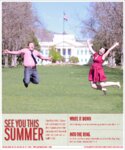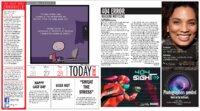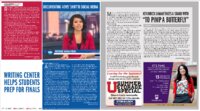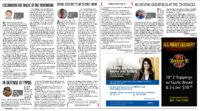| OCR Text |
Show BY CHRISTINE KANNAPEL /STAFF WRITER PHOTO COURTESY OF ROSIE NGUYEN osie Nguyen, a graduate student at the U, is creating a documentary about how the Internet has altered the face of news reporting. With a background in communication and journalism, Nguyen is making a film for a final project. She's titled it "The Correlation Between Social Media Engagement and Viewership Levels in TV News" because it examines how social media has helped and hurt television broadcasts. "I am focusing on how well their social media strategy aids with drawing viewers in and what other outlets are competing": Nguyen said. According to her ratings, the number of viewers watching news on TV has dropped by 50 percent in the past 10 years. Nguyen thinks it is due to the Internet providing news more quickly. So far she has discovered that about 50 percent of TV viewers between 18 and 24 years of age get their news through apps, such as Facebook and Twitter. After she collects more data, Nguyen plans to predict where the television industry will be in 10 years. "The documentary is aimed at anyone who is involved in news gathering, news production and news consumption": she said. "This includes journalists, news viewers and users of social media." Nguyen is working with ABC Channel Four in Utah and Craig Wirth, a graduate committee member. She is interviewing students at the U on their news consumption habits, as well as people who have worked in the news industry. She said the best part of creating this documentary was the process. Bradon Anderson, a senior in English, said he's noticed people becoming more dependent on online news, including himself. "People relate to others from around the world, like penpals, without having to engage in person": he said. "This plays out in news because people can just tweet, rather than watch the TV." For more information on Nguyen and her project, or if you want to get involved, email her at r.nguyen@utah.edu . R DOCUMENTING NEWS' SHEN SOCIAL MEDIA NA KSL ROSIE NGUYEN 44 c.kannapel@chronicle.utah.edu @chriswritine .400 BY TAYLOR ALMOND/STAFF 4 { THECHRONY I NEWS I OPINION I ARTS I SPORTS I TUESD AY, APRIL 28, 2015 } — 7 WRITER s the end of the semester approaches, appointments at the U Writing Center in the Marriott Library are filling up fast, and walk-ins are frequent. However, just up the road, the Spencer Fox Eccles business building's writing center location had nearly no appointments — only four of the available 24 slots were used as of press time. When the library's writing center opened in 2003, it was similarly empty. According to The Daily Utah Chronicle archives, ASUU gave the center a year of funding when it first opened. At the time, the U was the only college in Utah to not have a writing service for students, but the program needed to demonstrate demand. Only 800 appointments were filled its first semester, amounting "to tutors helping students with their writing approximately 70 hours per week:' Furthermore, students complained about the center's "stringent set of rules': which they argued made it more difficult to use the resource. Hours of operation and the number of appointments a student could fill a day were limited. If you missed three appointments, you would be barred from making more. In addition, some students were worried about their work being A WRITING CENTER HELPS STUDENTS PREP FOR FINALS aking a statement is the trendy thing to do these days. If you're social-media savvy, you use Instagram to tell your legions of followers which angles of your face are the best (I'll wait while you take a selfie). If you're outdoorsy, you rally in public about air pollution while sporting dreadlocks and Birkenstocks, and if you're Patricia Arquette, you use the Oscars as a literal stage for gender equality (and putting your foot in your mouth about other social movements). If you're Kendrick Lamar, you make the most politically and socially aware hip-hop album the industry has seen since Tupac Shakur dropped "Strictly 4 My N.I.G.G.A.Z..." in 1993. Lamar's "To Pimp a Butterfly," released in March 2015, reached No. 1 on the Billboard charts, but he's not looking to make a top-of-thepop-charts statement with this one. While his previous album, "good kid, m.A.A.d. city" (2012) focused more specifically on the struggles a young black man endures growing up in Compton, Lamar takes on a larger role in "To Pimp a Butterfly" as a spokesperson tasked with illustrating the social injustice against people of color in America. The album is complex and flavored with a variety of themes and musical styles. Lamar rides in on James Brown-esque bass grooves to discuss the effects of fame and public image, and then follows up with the temptations of the devil to the tune of a jazz piano. While a few tracks are radio-friendly and backed by a beat that more casual listeners can enjoy, the best way to consume this album is in its entirety, from top to bottom. The 16-track composition is connected by a side that Lamar seems to be giving to his younger self. Beginning with the funk-based "King Kunta," which details the public perception of his success as a black man, Lamar concludes the song with "I remember you was conflicted, misusing your influence." He builds on this phrase on five other tracks, wrapping up with the final song of the album, "Mortal Man," by saying, "Just because you wore a different gang color than mine's, doesn't mean I can't respect you as a black man ... If I respect you, we unify and stop the enemy from killing us. But I don't know. I'm no mortal man. Maybe I'm just another n " criticized or didn't think their writing needed the center's guidance. Some students, when they went to the center and subsequently failed the assignment, blamed the tutor and not their work. Beyond working with students, ASUU only gave the writing center $25,000 in funding — not enough to provide an adequate wage for tutors and faculty, as well as maintain operational costs. Back then, the center was located in a corner of the third floor of the library. Away from its now-prominent location above the west entrance, few students knew it even existed. In March of 2004, it was unsure whether or not funding would continue. However student feedback for the program ensured it would. In a 2005 Chrony interview, one student said: "If it wasn't for the writing center, I would be flunking two of my classes. The tutors there have a way of talking to me better than my teacher:' By 2008, nearly 2,000 students were being tutored each year — a jump from the 800 a semester when it first opened. In 2009, the center relocated to its current location, where it continues to help students throughout the school year. Lalmond@chronicle.utah.edu @SeymourSkimmer Leaving for the Summer? STOR-N-LOCK has great discount storage rates just for U of U students! SUMMER STORAGE SPECIAL KENDRICK LAMAR TAKES A STAND WITH "TO PIMP A BUTTERFLY" BY EMILY MEANS /COPY EDITOR While it's obvious (and has been for the past 300 years) that the oppression of black people is institutionally instated by white America, Lamar believes initiating change comes from within the black community — if black people respect each other and black-on-black crime ceases to exist, the community will be more united in their efforts against racial inequality. Lamar isn't speaking from a holier-than-thou standpoint, though. In "The Blacker the Berry," he calls himself the "biggest hypocrite of 2015," crying when Trayvon Martin was shot, though "gang banging" has put the blood of black men on his own hands. Similarly, in "Mortal Man" Lamar questions the loyalty of his listeners if he were to be accused of something or to lose support from the media. He realizes the power his words have as a public figure and sees himself as the next voice in a long line of leaders, from Nelson Mandela to MLK to Tupac Shakur. Realizing the vulnerability and rejection that comes with speaking out against political and social standards, Lamar encourages his listeners and the black community to continue supporting him in bringing change and awareness to the status quo. It's a big statement. Kendrick Lamar tackles black stereotypes, institutional oppression and the changes that fame and recognition bring to a person (what could easily be the subjects of three different sociology classes) in one 79-minute record. If there's an artist willing to take Tupac's torch and expose social injustice to American youth through a medium they're already paying attention to, it's a statement worth listening to. e.means@chronicle.utah.edu @ChronyArts IT'S TIME GRADUATE PROGRAMS AT WESTMINSTER 13 im ■ ar GRADUATE PROGRAMS IN THE FOLLOWING AREAS: Business Communications Community Leadership Counseling Education Nursing Stor-n-Lock.com/uofu Call 801-803-6510 for details. STOR-N-LOCK •SELF STORAGE••• WESTMINSTER SALT LAKE CITY • LITAH 801.832.2200 westminstercollege.edu/grad 5 |










